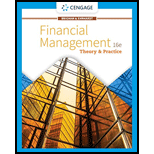
Financial Management: Theory & Practice
16th Edition
ISBN: 9781337909730
Author: Brigham
Publisher: Cengage
expand_more
expand_more
format_list_bulleted
Question
Chapter 7, Problem 7MC
Summary Introduction
Case summary:
Employer of person X is considering an expansion into a similar filed which includes acquisition of Company T. He is also considering purchasing Company BM each with 5 million shares of stock.
The company has
To determine: The percentage of Company BM’s value of operations at year0 is due to the cash flows from year 4 and then beyond it if Company BM undertakes to expand.
Expert Solution & Answer
Trending nowThis is a popular solution!

Students have asked these similar questions
A comparative balance sheet and income statement is shown for Cruz, Incorporated.
CRUZ, INCORPORATED
Comparative Balance Sheets
At December 31
2021
2020
Assets
Cash
Accounts receivable, net
$ 85,600
36,800
$ 21,300
Prepaid expenses
Inventory
Total current assets
Furniture
Accumulated depreciation-Furniture
Total assets
Liabilities and Equity
Accounts payable
Wages payable
77,100
45,200
84,900
4,700
3,900
204,200
155,300
94,700
(14,700)
$ 284,200
$ 13,400
8,000
(8,400)
$ 257,400
$ 19,000
4,500
110,500
Income taxes payable
1,400
2,500
Total current liabilities
Notes payable (long-term)
Total liabilities
Equity
Common stock, $5 par value
Retained earnings
22,800
26,000
28,900
66,400
51,700
92,400
204,000
28,500
162,300
2,700
Total liabilities and equity
$ 284,200
$ 257,400
CRUZ, INCORPORATED
Income Statement
Sales
For Year Ended December 31, 2021
$ 440,700
283,700
157,000
Cost of goods sold
Gross profit
Operating expenses (excluding depreciation)
Depreciation expense
Income before taxes…
How do you calculate the intrinsic value of a stock using the dividend discount model (DDM)? Need help.
Explain the Modigliani-Miller theorem and its assumptions In finance?
Chapter 7 Solutions
Financial Management: Theory & Practice
Ch. 7 - Two investors are evaluating General Electric’s...Ch. 7 - A bond that pays interest forever and has no...Ch. 7 - Explain how to use the free cash flow valuation...Ch. 7 - Ogier Incorporated currently has $800 million in...Ch. 7 - EMC Corporations current free cash flow is 400,000...Ch. 7 - Prob. 3PCh. 7 - JenBritt Incorporated had a free cash flow (FCF)...Ch. 7 - Blunderbluss Manufacturing’s balance sheets report...Ch. 7 - Thress Industries just paid a dividend of $1.50 a...Ch. 7 - Boehm Incorporated is expected to pay a 1.50 per...
Ch. 7 - Woidtke Manufacturing’s stock currently sells for...Ch. 7 - A company currently pays a dividend of $2 per...Ch. 7 - Nick’s Enchiladas has preferred stock outstanding...Ch. 7 - Brook Corporation’s free cash flow for the current...Ch. 7 - Kendra Enterprises has never paid a dividend. Free...Ch. 7 - Dozier Corporation is a fast-growing supplier of...Ch. 7 - Brushy Mountain Mining Companys coal reserves are...Ch. 7 - Prob. 15PCh. 7 - Crisp Cookware’s common stock is expected to pay a...Ch. 7 - Prob. 17PCh. 7 - Assume that the average firm in C&J Corporation’s...Ch. 7 - Simpkins Corporation does not pay any dividends...Ch. 7 - Several years ago, Rolen Riders issued preferred...Ch. 7 - You buy a share of The Ludwig Corporation stock...Ch. 7 - You are analyzing Jillians Jewelry (JJ) stock for...Ch. 7 - Reizenstein Technologies (RT) has just developed a...Ch. 7 - Conroy Consulting Corporation (CCC) has a current...Ch. 7 - Start with the partial model in the file Ch07 P25...Ch. 7 - Prob. 26SPCh. 7 - Start with the partial model in the file Ch07 P27...Ch. 7 - Describe briefly the legal rights and privileges...Ch. 7 - Prob. 2MCCh. 7 - Use a pie chart to illustrate the sources that...Ch. 7 - Suppose the free cash flow at Time 1 is expected...Ch. 7 - Use BMs data and the free cash flow valuation...Ch. 7 - You have just learned that B&M has undertaken a...Ch. 7 - Prob. 7MCCh. 7 - Prob. 8MCCh. 7 - Prob. 9MCCh. 7 - What is the horizon value at Year 4? What is the...Ch. 7 - Prob. 11MCCh. 7 - Prob. 14MCCh. 7 - Prob. 15MCCh. 7 - Assume that Temp Force is a constant growth...Ch. 7 - Prob. 17MCCh. 7 - Prob. 18MCCh. 7 - Prob. 19MCCh. 7 - Prob. 20MCCh. 7 - Prob. 21MC
Knowledge Booster
Similar questions
- How do you calculate the intrinsic value of a stock using the dividend discount model (DDM)? i need coarrow_forwardHow do you calculate the intrinsic value of a stock using the dividend discount model (DDM)?arrow_forwardHow does the weighted average cost of capital (WACC) affect a company’s valuation? i need help in this qarrow_forward
- How does the weighted average cost of capital (WACC) affect a company’s valuation?i need correct answer.arrow_forwardHow does the weighted average cost of capital (WACC) affect a company’s valuation?i need help.arrow_forwardHow does the weighted average cost of capital (WACC) affect a company’s valuation? Need helparrow_forward
arrow_back_ios
SEE MORE QUESTIONS
arrow_forward_ios
Recommended textbooks for you
 Intermediate Financial Management (MindTap Course...FinanceISBN:9781337395083Author:Eugene F. Brigham, Phillip R. DavesPublisher:Cengage Learning
Intermediate Financial Management (MindTap Course...FinanceISBN:9781337395083Author:Eugene F. Brigham, Phillip R. DavesPublisher:Cengage Learning

Intermediate Financial Management (MindTap Course...
Finance
ISBN:9781337395083
Author:Eugene F. Brigham, Phillip R. Daves
Publisher:Cengage Learning
